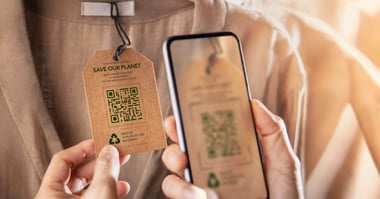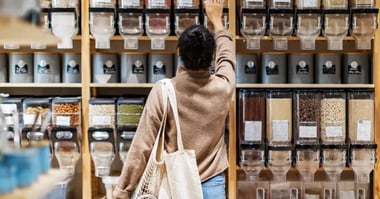
Tamara Davison
Tamara Davison is a journalist who specializes in sustainability and the environment. Reporting from around the world, she's seen firsthand the direct impact waste is having on coastal communities and our oceans. As a diver trained in ecological monitoring, the changes Tamara has seen in marine habitats inspired her to action. She's previously written for The Guardian, The Independent and the Evening Standard. She's also produced environmental documentaries for EuroNews.
Around 95% of cosmetic packaging is thrown away after its initial use, according to the British Beauty Council. What's alarming is that most of this ends up in landfills or pollutes our oceans — but it's time for that to change.
The good news is the beauty industry no longer needs to rely on plastic packaging. The concept of waste is changing as we edge toward a circular economy model. We're here to show you how to make this happen, highlighting nine different ways beauty brands can reduce plastic packaging.
Want to find out how your beauty brand can reduce plastic waste? Check out our guide on Sustainable Strategy for Beauty Brands, where you can find advice on how to reduce your plastic packaging, the benefits of introducing a greener strategy, and guidance on the first steps.
What’s on this page?
01 | Summary: Top 9 ways to reduce plastic waste in the cosmetics industry02 | Guide to reducing plastic waste
03 | Examples of beauty brands cutting back on plastic
04 | How much waste does the beauty industry create?
05 | Summary
06 | FAQs
Top 9 ways to reduce plastic waste in the cosmetics industry
|
Rank |
Method |
Description |
|
1 |
Explore packaging alternatives |
Consider implementing glass or biodegradable packaging to reduce your plastic footprint |
|
2 |
Embrace a refillable product model |
Offer refillable products to eliminate unnecessary waste and to encourage a loyal customer base |
|
3 |
Consider plastic offsetting initiatives |
Work with your shoppers to support communities around the world by removing plastic from our oceans |
|
4 |
Stop using packaging altogether |
Opt for waterless products to reduce the consumption of natural resources |
|
5 |
Offer supersized options |
Encourage shoppers to buy big instead of needing to purchase multiple packages |
|
6 |
Create a sustainable supply chain |
Work with partners to eradicate plastic waste through your supply chain |
|
7 |
Reassess the lifecycle of unsold or damaged stock |
Find value in products that may otherwise be disposed of unnecessarily |
|
8 |
Eliminate excess packaging |
Cut out unnecessary boxes and plastic packaging that only benefit aesthetics |
|
9 |
Champion transparency |
Share your sustainability story to inspire other brands to get involved |
1. Explore packaging alternatives
Around 70% of the beauty industry’s waste comes from packaging, according to the British Beauty Council — most of which isn’t recycled. There are many reasons for this: perhaps cosmetic residue was left inside the products, or they’re made from non-recyclable plastic.
However, alternative packaging options could combat this plastic waste.
Glass is a great option, as it’s easily recyclable and often gives products a luxurious feel. Companies can also market glass as a reusable container, reducing waste entering our environment.
Unfortunately, the weight of glass can be challenging for e-commerce brands. Although this can increase shipping costs, the sustainability benefits can outweigh price increases. Almost half of consumers surveyed by CleanHub said they would pay more for products that come in sustainable packaging.
Alternatively, organic packaging solutions made from bamboo or seaweed are growing in popularity. These are abundant biodegradable materials that can hold liquids, soaps, and creams.
What makes them so sustainable? Well, bamboo forests are fast-growing and difficult to burn, which will be beneficial in light of future global warming, and means crops can be replenished quickly.
2. Embrace a refillable product model
Refillable cosmetics cut down on packaging waste because it encourages consumers to reuse the same container. This not only reduces plastic waste but also enhances customer loyalty as they repurchase the same product.
Cosmetic Business found that makeup refill sales soared by 364% in 2022. Luxury brands, such as Charlotte Tilbury and Prada, have driven growth in the refillable cosmetic market by embracing refillable products.
Interestingly, Cosmetic Business’s survey also suggests that under 24% of consumers currently use refillable products. So although the refillable market is growing, simplifying the process for customers is crucial.
3. Consider plastic offsetting initiatives
Our research shows that 64% of shoppers expect brands to offer better schemes for removing plastic packaging. Plastic offsetting is an innovative way to support communities globally, while also reducing ocean waste.
For every purchase, cosmetic brands invest in initiatives working to extract plastic from the environment. This allows beauty brands to contribute actively to reducing the plastic they produce while demonstrating a sustainable commitment to their customers.
There are lots of platforms that can integrate this feature, including Shopify. Want to see how Shopify can make your cosmetics business greener? Check out our helpful guide: How to Make An Eco-Friendly Ecommerce Business With Shopify.
4. Eliminate excess packaging
The cosmetics industry produces roughly 120 billion units of plastic packaging per year. But how many of these products also come with excess packaging?
Manufacturers tend to seal many products with a layer of plastic or pack them in cardboard boxes. Sometimes this is for hygiene purposes, but in a lot of instances, excess packaging is nothing more than aesthetics.
A study in Recycling Today revealed consumers' growing frustration with unnecessary packaging, such as large boxes and plastic tape. Among those surveyed, 38% of people found half of their deliveries were filled with air.
5. Stop using packaging altogether
An estimated 552 million shampoo bottles are sent to landfill each year, according to a Washington Post report. Up to 80% of these products are made from water, adding to both plastic container waste and water consumption.
Good alternatives to these water-based cosmetics include shampoo bars and natural crystal deodorants. These products can reduce the environmental footprint of the cosmetic market as they don’t require as much water and can be packaged in smaller containers.
Solid products require little (if any) packaging and they also occupy less space than water-based products. This makes transporting products more efficient and cost-friendly as trucks fit more products.
6. Offer supersized options
Loyal customers often repurchase their favorite products. So why not satisfy your customers while also being kind to the planet?
Selling products in 1-liter or 2-liter containers means there’s less packaging wasted, as products can be used for longer and customers require fewer orders. Fewer deliveries to customers reduce carbon emissions during shipping.
In 2022, Cosmetic Business reported a 23% growth in UK sales of both supersized and potent formulas compared to the previous year. Help your customers remain stocked up and be kind to the planet by supersizing your offerings.
7. Create a sustainable supply chain
Beauty brands can’t bear the responsibility of plastic reduction alone. Make sure partners across your supply chain are similarly committed to cutting out plastic waste.
You could work with your transport partners to develop packaging methods that allow trucks to carry more content. Or why not switch from boxes to cardboard envelopes, to consume less space and produce less waste? You could even work with other companies to boycott major consumption events, such as Black Friday.
At the other end of the sales funnel, retailers can also ditch glossy bags and luxury in-store packaging, demonstrating to customers that the entire retail process is placing sustainability first.
8. Reassess the lifecycle of unsold or damaged stock
Have you ever wondered where unsold cosmetic inventory ends up? If products expire or are damaged in transit, many retailers send them back to the manufacturers. The reality is that some of this might end up in landfills.
A small but growing number of brands are selling damaged products at lower price points. Flavedo and Albedo re-sell ‘imperfect picks’ on their website. Recommerce brands such as This Is Beauty and You From Me help to keep products in circulation. Unsurprisingly, it’s what is on the inside that counts. Many consumers buy products even if boxes are damaged or the product lines are discontinued.
Damaged goods still have value, and it’s crucial in our throwaway culture to start celebrating that.
9. Champion transparency
Brands that are transparent about their plastic footprint will play a vital role in our sustainable future. These cosmetic leaders can inspire customers, and other beauty labels, to get involved.
When you share regular reports on the benefits of waste reduction, you motivate beauty lovers to think about buying refillable products or supersized packages. This is backed by the Beauty Independent, which said that Gen Z and Millennial customers were more likely to pay more for brands that embrace transparency.
Other beauty brands will also see from your actions that a clear commitment to reducing plastic waste attracts loyal customers and delivers results.
Examples of beauty brands cutting back on plastic
A rising awareness of the negative impact of plastic is prompting change in the industry — and this movement is predicted to continue on an upward trajectory.
From beauty behemoths like L’Oreal to independent sustainable brands like UpCircle, cosmetic producers are constantly re-inventing packaging strategies.
What’s exciting is that there are so many ways that brands can approach this: from funding ocean-friendly initiatives like La Mer to reducing ingredient waste like Sunday Riley.
We’re confident that more refillable products and plastic alternatives will emerge in the cosmetic market in the coming years. This means now is a crucial period for brands that don’t want to get left behind.
Want to learn more about the cosmetic brands championing sustainability? Check out our page: Top 9 Beauty Brands Leading the Charge in Sustainable Packaging.
How much waste does the beauty industry create?
It’s difficult to gauge the scope of waste produced by the beauty industry. The British Beauty Council reports that just 14% of plastic waste is sent to recycling and only 9% gets recycled, but that’s just the tip of the iceberg.
Few studies exist that factor in the beauty supply chain — from production to the shop floor. It’s almost impossible to know where waste produced along a product’s lifecycle ends up.
What we do know for sure is that a large majority of chemicals and plastic particles created by the beauty industry eventually break down and enter the environment. In some instances, microplastics are ingested by wildlife, enter our food chain, and are consumed by humans.
Summary
The beauty industry’s environmental impact is a hot topic. By 2050, experts predict that there will be more plastic in our oceans than fish — the steps that the cosmetic industry takes now can help ensure this doesn’t become a reality.
From offering refillable products to backing plastic offsetting initiatives, there are many ways that beauty brands can reduce their plastic waste. What’s clear is that sweeping changes with the environment in mind are both necessary and supported by consumers.
Want to find out how your beauty brand can reduce plastic waste? Check out our guide on Sustainable Strategy for Beauty Brands, where you can find advice on how to reduce your plastic packaging, the benefits of introducing a greener strategy, and guidance on the first steps.
FAQs
How can we reduce waste in the beauty industry?
Manufacturers can focus on switching plastic containers for reusable alternatives. Consumers can shop from brands that show a commitment to sustainability, and make sure they actually commit to refill programs.
How can we reduce makeup waste?
Support makeup brands that are working toward a waste-free future. These are brands that offer recycling programs, refill initiatives, and champion natural ingredients.
What other solutions are being developed to avoid plastic cosmetic containers?
A number of biodegradable alternatives to plastic packaging have emerged on the beauty market. This includes containers made from bamboo, seaweed, and beeswax.
Alternatively, we’re also seeing more brands switch to glass bottles or explore refill practices to reduce unnecessary waste. These plastic alternatives can help brands edge toward a more sustainable future.

.webp)

.webp?width=380&name=Cosmetics%20(1).webp)
.webp?width=380&name=Plastic-free-soap%20(1).webp)
.webp?width=380&name=Refill%20product%20(1).webp)



.webp?width=380&name=recycling%20(1).webp)


.webp?width=380&name=Paper-packaging%20(1).webp)
